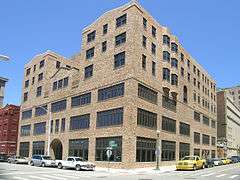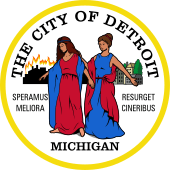Women's City Club
|
Women's City Club | |
 | |
| Location |
2110 Park Avenue Detroit, Michigan |
|---|---|
| Coordinates | 42°20′14″N 83°3′10″W / 42.33722°N 83.05278°WCoordinates: 42°20′14″N 83°3′10″W / 42.33722°N 83.05278°W |
| Built | 1924 |
| Architect | William B. Stratton; Waldridge & Aldinger |
| Architectural style |
Arts and Crafts, Early Modern |
| Part of | Park Avenue Historic District (#97000396) |
| NRHP Reference # | 79001179[1] |
| Significant dates | |
| Added to NRHP | November 20, 1979 |
| Designated CP | May 13, 1997 |
| Designated MSHS | April 29, 1979[2] |

The Women's City Club is a women's club located at 2110 Park Avenue in Downtown Detroit, Michigan, within the Park Avenue Historic District. It was listed on the National Register of Historic Places and designated a Michigan State Historic Site in 1979.[1][2]
History
Women's organizations became increasingly influential in the years after the American Civil War as a class of highly educated, middle class women arose in the nation.[3] Their impact was at its peak in the years around World War I, when the 19th Amendment, guaranteeing women's suffrage, was ratified. In Detroit, it became apparent at that time that the many women's organizations in the city needed a centralized place to meet.[4] In 1919, a number of local activists founded the "Women's City Club" to "promote a broad acquaintance among women."[3][5] The club hired architect William B. Stratton (husband of ceramicist and club member Mary Chase Perry Stratton) to design a suitable building; the structure was completed in 1924.[5][6]
Description
The exterior of the building is built of brick, in a featureless modern style.[4] The six stories are differentiated into the lower three floors, which are blocky and regular; and the three upper floors, which appear to be set onto the lower floors.[3][5] The brick color differs between the two sections, as does the appearance of the windows. There is also a horizontal range of bricks between the two sections.[3] The lower floors were designed to be meeting spaces for social events and planning the activities of members. The three upper floors were used as an apartments for women who moved to Detroit for employment and wished to live in a wholesome environment.[3]
The interior decor was strongly influenced by the then-current Arts and Crafts movement, with hand-wrought ironwork and Pewabic Pottery tilework.[4] The swimming pool was also decorated with Pewabic tile.[3]
Use
The City Club offered a number of classes and recreation programs for women, eventually enrolling over 8,000 members.[4] However, membership declined after World War II,[4] and in 1974 the club moved to smaller quarters.[3] The social space was used for various purposes, including a restaurant and bar in later years.[3] The building is currently owned by Forbes Management (also owners of the Elwood Bar, Gem Theater, and The Fillmore Detroit), and has recently received an upgrade of its façade.[7]
References
- 1 2 National Park Service (2008-04-15). "National Register Information System". National Register of Historic Places. National Park Service.
- 1 2 "Women's City Club of Detroit". Michigan State Housing Development Authority. Retrieved September 3, 2010.
- 1 2 3 4 5 6 7 8 Women’s City Club of Detroit from Detroit1701.org
- 1 2 3 4 5 Women's City Club from the National Park Service
- 1 2 3 Hill, Eric J. and John Gallagher (2002). AIA Detroit: The American Institute of Architects Guide to Detroit Architecture. Wayne State University Press. ISBN 0-8143-3120-3. P. 62.
- ↑ Sharoff, Robert (2005). American City: Detroit Architecture, 1845-2005. Wayne State University Press. ISBN 0-8143-3270-6. P. 41.
- ↑ "Women's City Club building on Park Ave. gets facade upgrades" fropm ModelD, December 19, 2006


